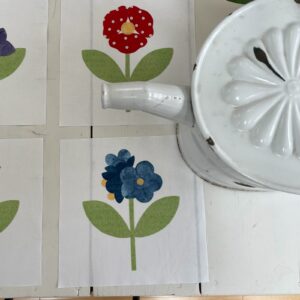by Great Joy Studio | Feb 25, 2020 | Quilting & Fabric

•
Hat Shop Sew-A-Long, last post.
Adding your borders is all that is left to do!
This can be done in a couple of different ways however, I will only be describing how I actually, chose to finish this quilt.
Borders.
First up, the inner 1″ (finish size) black border. Make sure that your window blocks are squared up by trimming, measuring and placing your tracings over them before you add this border. Pay special attention to you last row of blocks so that all of the items will appear to be sitting on the bottom shelf of your window. It was necessary for me to trim mine about 1/2″. Then pin and sew with your 1/4″ seam.

•
Secondly sew on your gray borders to three sides. Top, right and left. I cut them 2″ for an inch and a half finish.
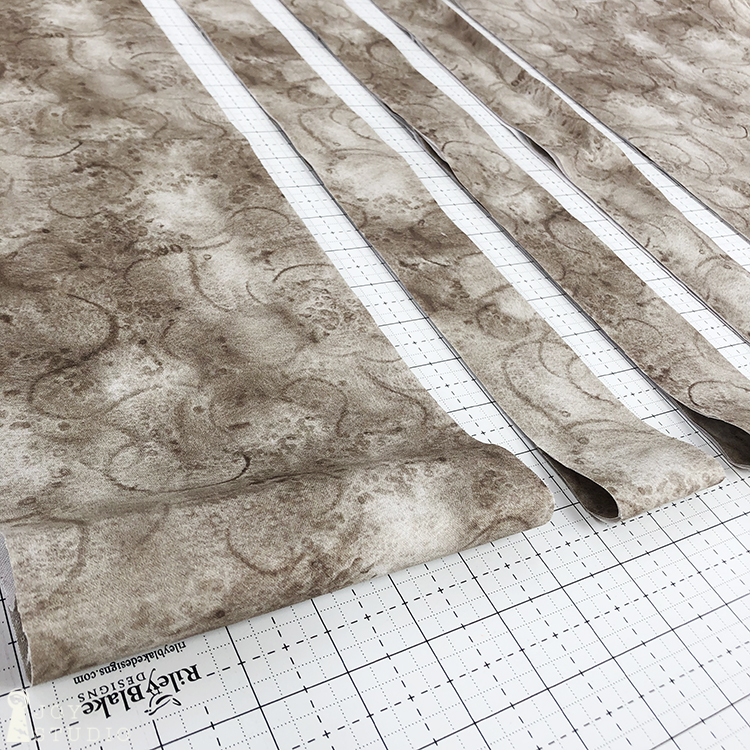
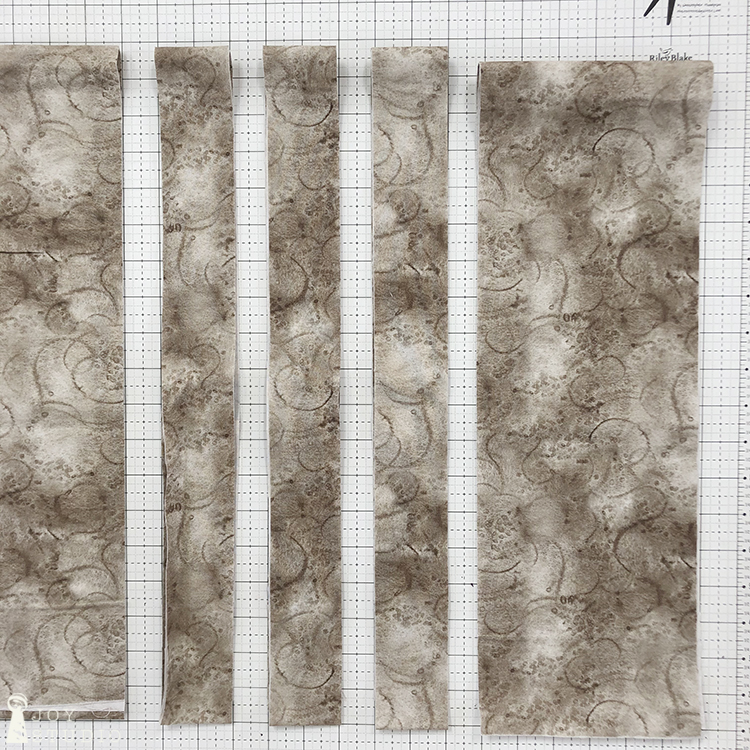
•
Bottom border.
Because I did not want to stitch around the appliquéd bricks after the borders were added to the quilt top, I simply strip pieced both of the borders together to treat the entire unit as the bottom border. Then I arranged the bricks (omitting one) making up the window sill approximately 1/4″ or so apart, evenly to fit directly under the black inner border. When I was satisfied with the placement, I fused the bricks to the gray and black unit, overlapping the seam slightly. This made stitching down the bricks much easier to manage than turning the entire quilt. I did however, stray from the pattern a bit. As you can see, the brick window ledge was confined to the bottom border only. You can choose to add two more bricks, one on each end after you add your side borders. I plan to do this as I show in the last photo in the segment below.




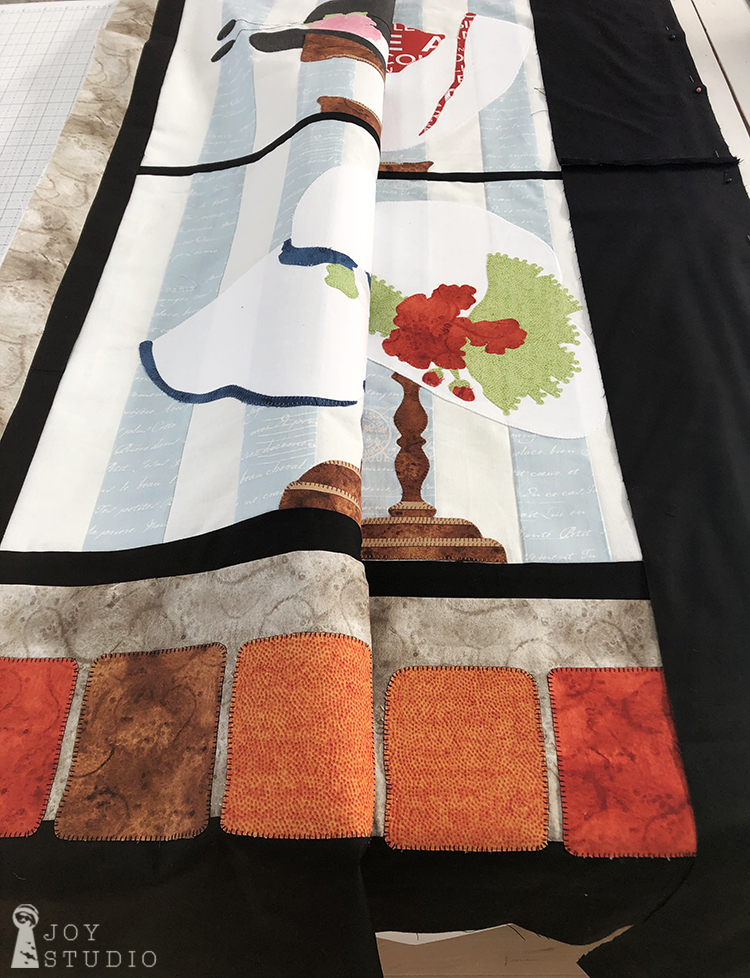
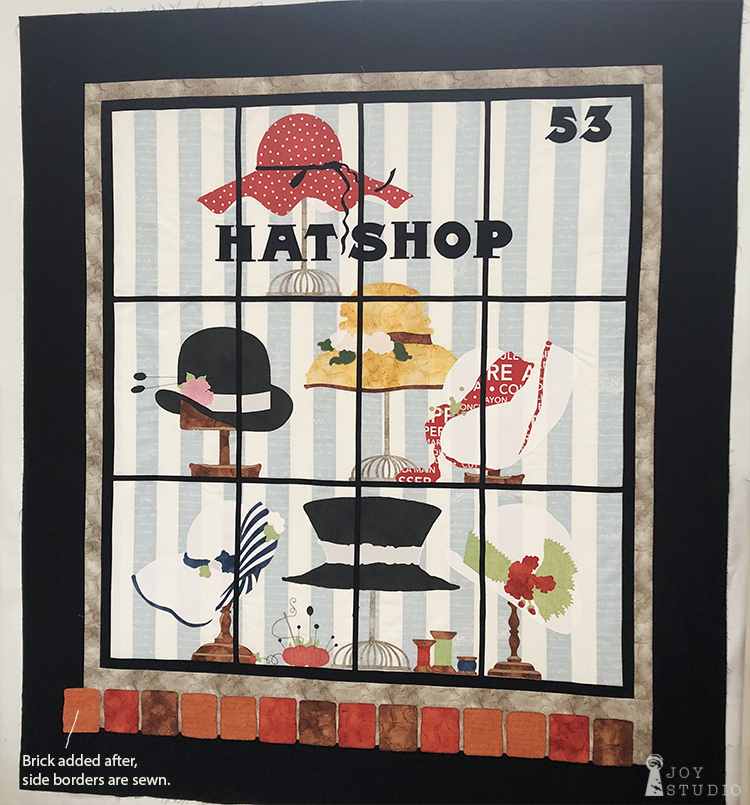
•
If you made it through the Hat Shop SAL, be proud of yourself! I was, and also quite surprised. This was a very intimidating challenge for me but I pushed through and learned much by making this project. Now my top is off to the quilter and I will share the finished piece with you soon.
Instagram @jweckerfrisch
Facebook Joy Studio

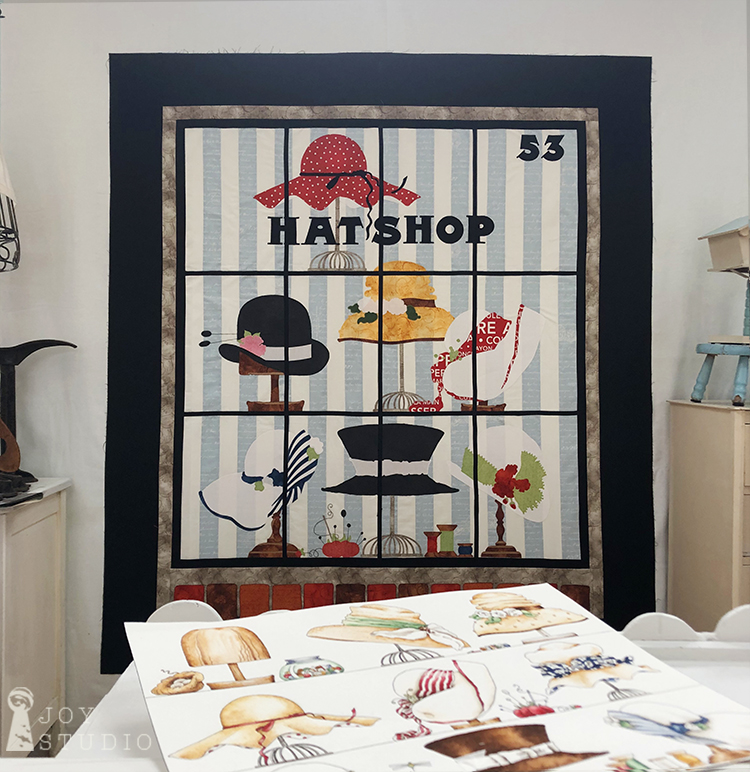
From ART to APPLIQUÉ.
Thanks for following and hopefully, sewing-a-long.
So long, for now.

by Great Joy Studio | Feb 18, 2020 | Quilting & Fabric
Hello Hatters!
We are coming into the Hat Shop home stretch now!!
Hopefully all of your blocks are fused, sewn down to secure your appliqué and you have added any embellishments or fancy stitching details that you care to create. Assuming this is the case, lets assemble your blocks.

•
Trimming the windowpane blocks.
Using your tracings that we made in Week 2, lay over each block one at a time. I started in row one and worked my way down. Carefully match your line drawing to your appliqué beneath and trim two sides (only) on the solid lines previously marked using the pattern. This was a scary step however, if you followed the pattern closely, items will meet up fairly well. So, trim all of your block sides in row one, then two and finally row three.


•
Sew each row together.
Once all four blocks in any given row are trimmed on each side (only), stitch the blocks together using a 1/4″ seam allowance. Peek underneath each one in an attempt to meet your corresponding appliqué pieces and then pin.

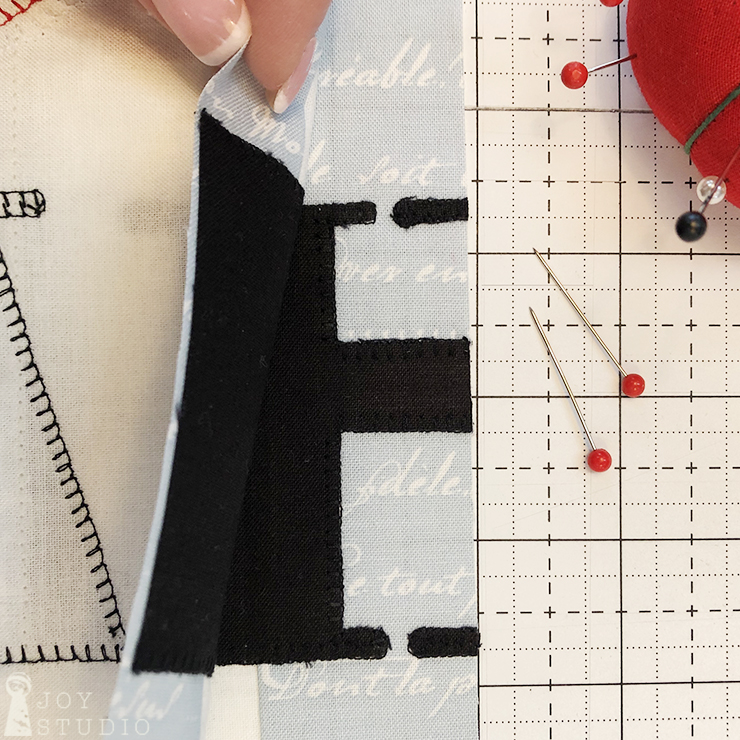
•
Your sewn rows will look something like the photos below.


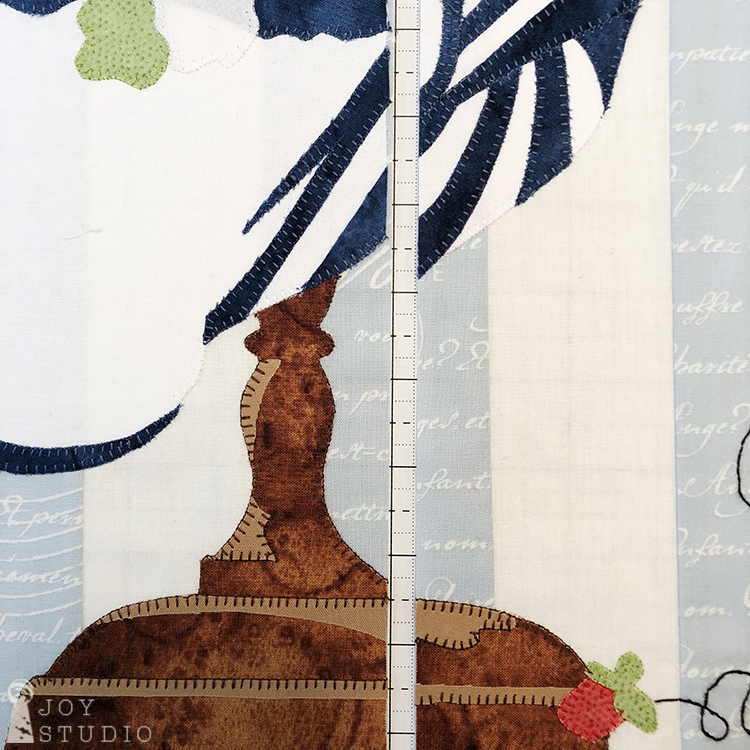

•
As you can see, mine are not perfect, not even sewn the same on each side however, two things I kept in mind as I pushed forward.
1) The window mullions will cover my seams and conceal any obvious errors.
2) I recently heard or read Jenny Doan remark, “finished is better than perfect.”
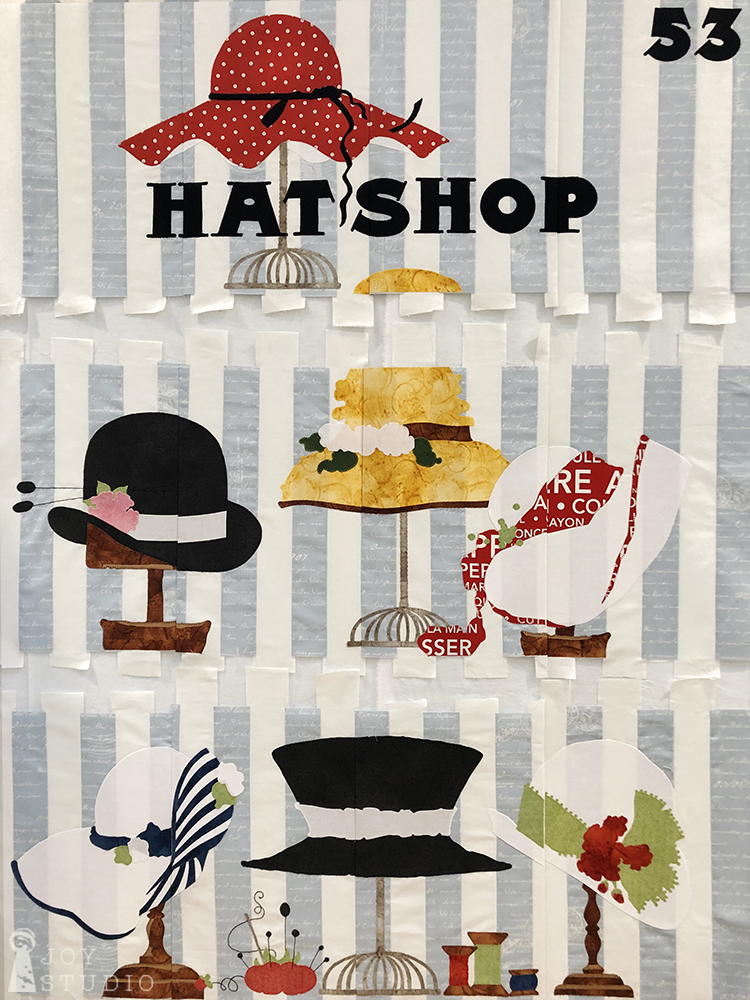
•
Next we trim again, top and bottom of each row. I wanted to see how my images lined up horizontally first so this is my suggestion. My rows ended up trimming to 16.5″ high, although the pattern cut line was at 17″. After you trim each row it’s time to attempt to match up the yellow hat appliqué and also the vertical background stripes. My primary focus was on the latter.

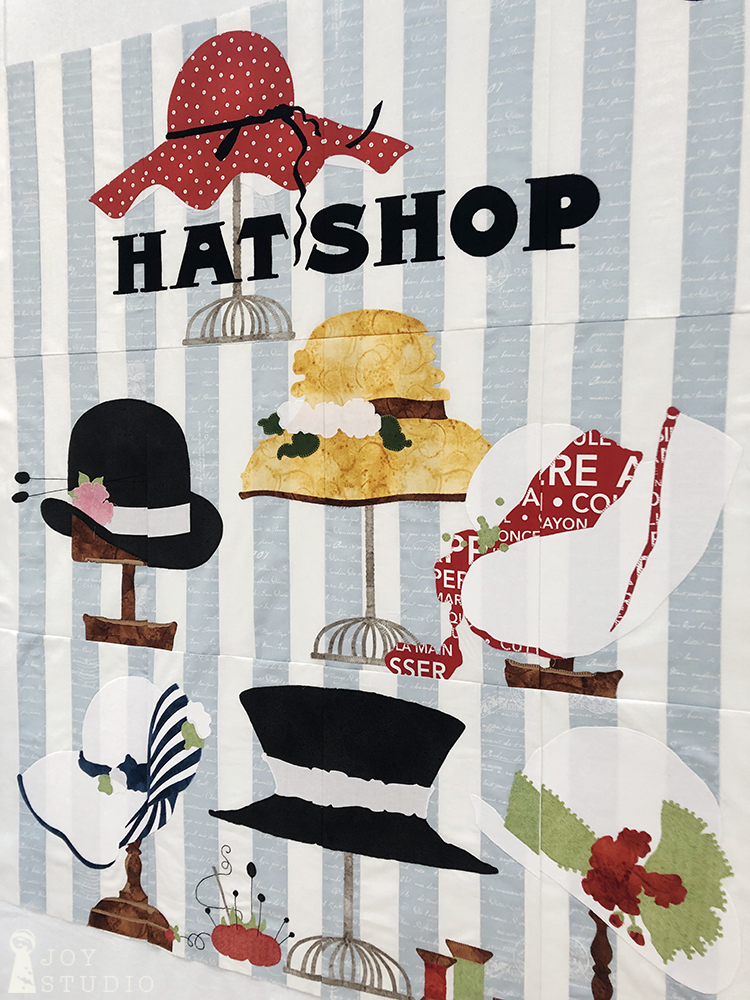
•
Making the window mullions.
We used Riley Blake Designs Confetti Cotton in black for the windowpane dividers. I did not have a half inch bias tape maker so I used the one just under. I cut six 7/8″ – 1″ strips selvage to selvage, not on the bias! We do not want these to stretch. Then I made my folded strips and pressed a double sided fusible tape on the back in which to cover my seams.
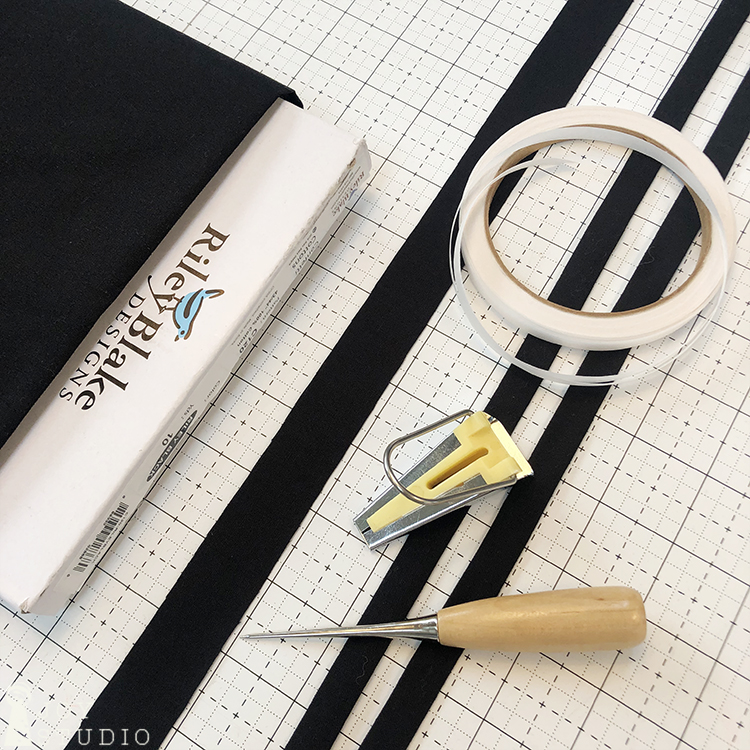
•
Next, press on your strips across the two horizontal seams. Then stitch the edges using a straight or decorative stitch.
Repeat the same for the three vertical dividers. I used the extra strip to piece the vertical strips as they were about 7- 9″ shy.


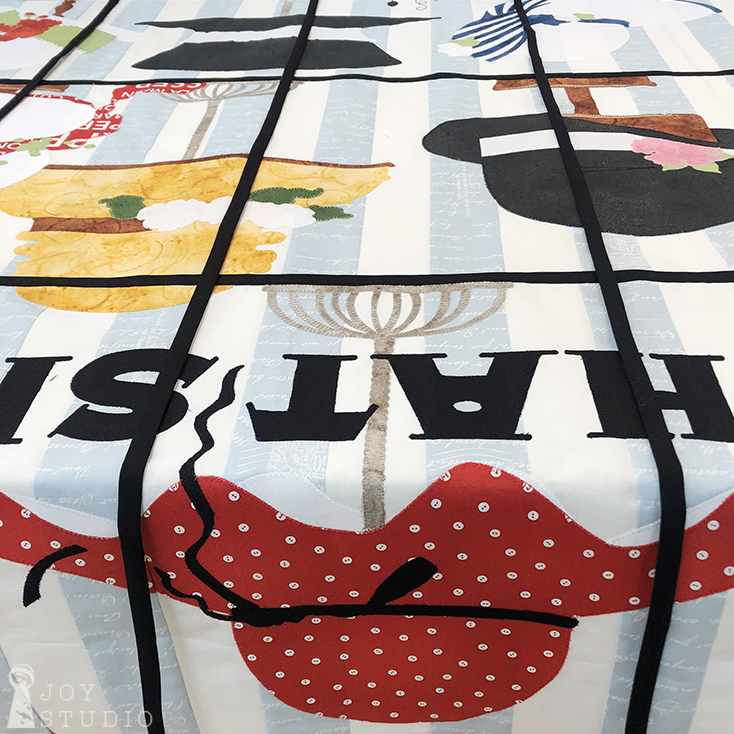
•
This sounds like a lot but really, it goes very quickly. In fact I’m sure that most of you will complete week 5 in a day! I did!!
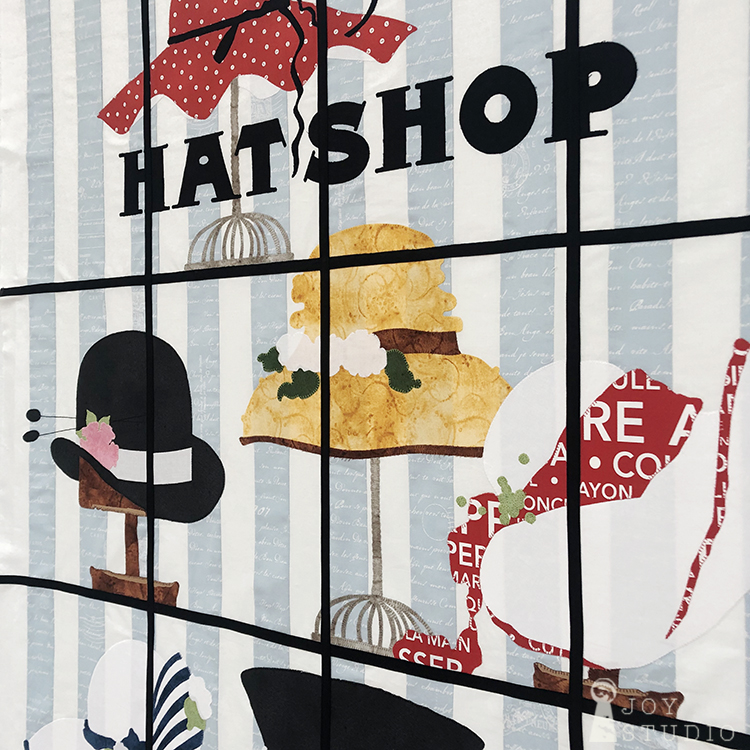
•
Next week, the borders and bricks. It will also wind up our sew-a-long.
If any of you would still like the BONUS hat, spools and button pattern, SHOW us your progress using #hatshopsewalong on your social media and leave me a comment or email. We’ll send just let us know:
janet@greatjoystudio.com

•
by Great Joy Studio | Feb 12, 2020 | Quilting & Fabric

Week 4, already?!!!!
We have been sewing down all of our appliqué pieces in rows 1 and 2. How about you?! We are still trying to figure out how we can patch our derby form correction so we will keep you posted in case you have the same problem.
To help us get a better view of our progress, we purchased materials to construct a much needed design wall. Refining is still underway but for now, it works. If you have the room I recommend one although I’m sure that most of you are way ahead of me on this already. We purchased 2, two inch thick, 4′ x 8′ sheets of styrofoam from a local building materials supplier and then covered them with flannel.
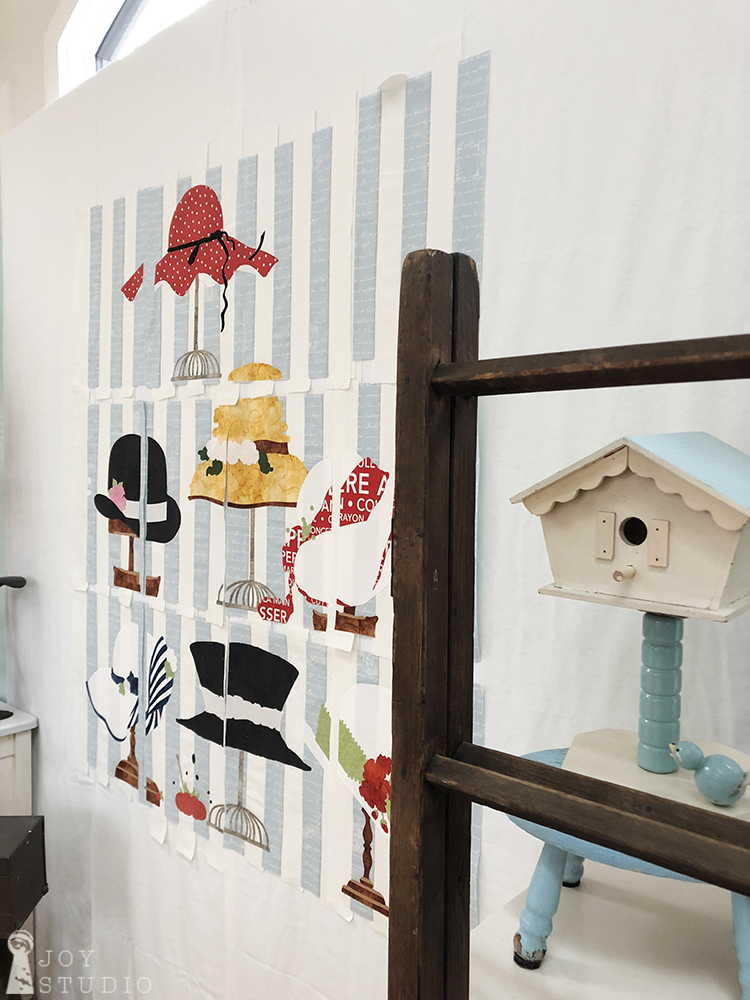
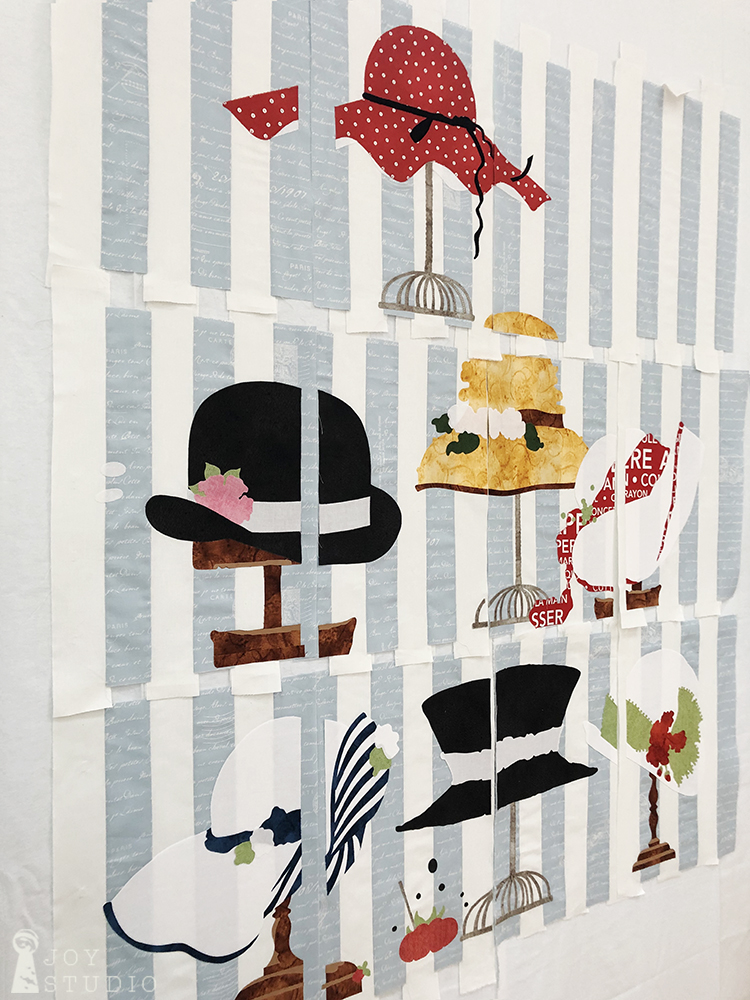
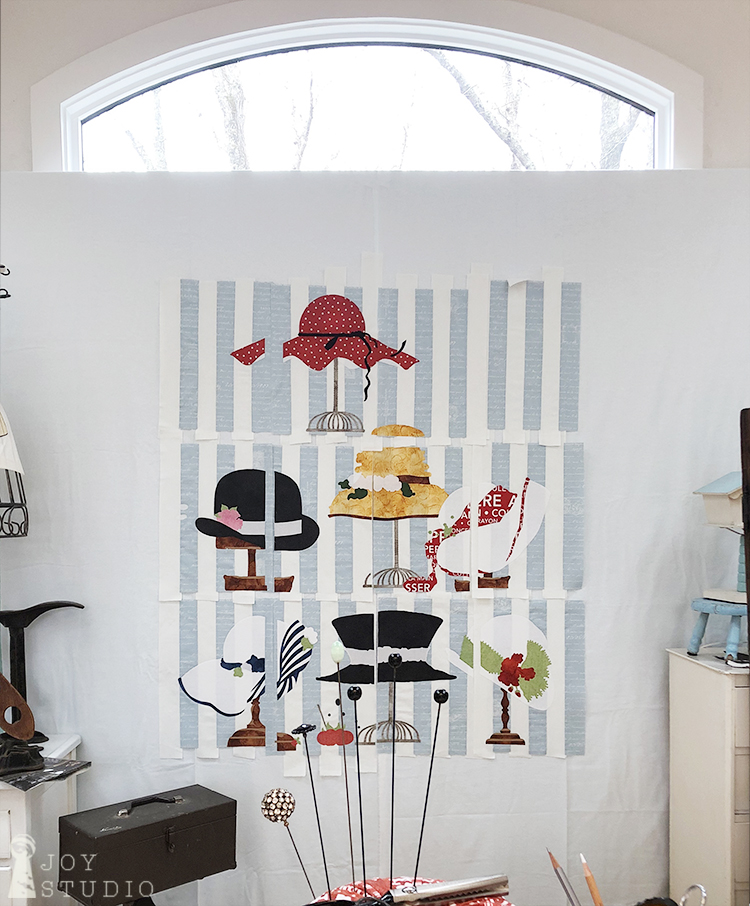
•
So, this week we finish the last four window blocks. Hurray!
Fusing row 3
Be sure to begin as we did last week by lining up your vertical striped background with the row above as you place your pattern tracing over each of your blocks. Review the images using this link and scroll down to Lining up the vertical stripes.
Likewise as in the week two, use your pattern tracing paper door method to begin placing and fusing all of your appliqué pieces. Review using this link and scroll down to Making an appliqué placement door.
Applique fusing sequence.
Repeating, the best way to determine what is fused first is by laying out all of your appliqué pieces on their corresponding blocks, underneath your tracing paper rendering, carefully checking with your pattern cover and technical illustration. Much like the red hat described in week 2 and the derby in week 3, the majority of the hats are fused in a similar order. Hat stand parts and then hat parts, However, hat one (left to right) took a bit more concentration figuring out the stripes. We cut a few of these pieces to go under each other, e.g. the hat brim stripe, which we added last. Shown here in these photos, the hat brim stripe covers the other angled stripe ends.
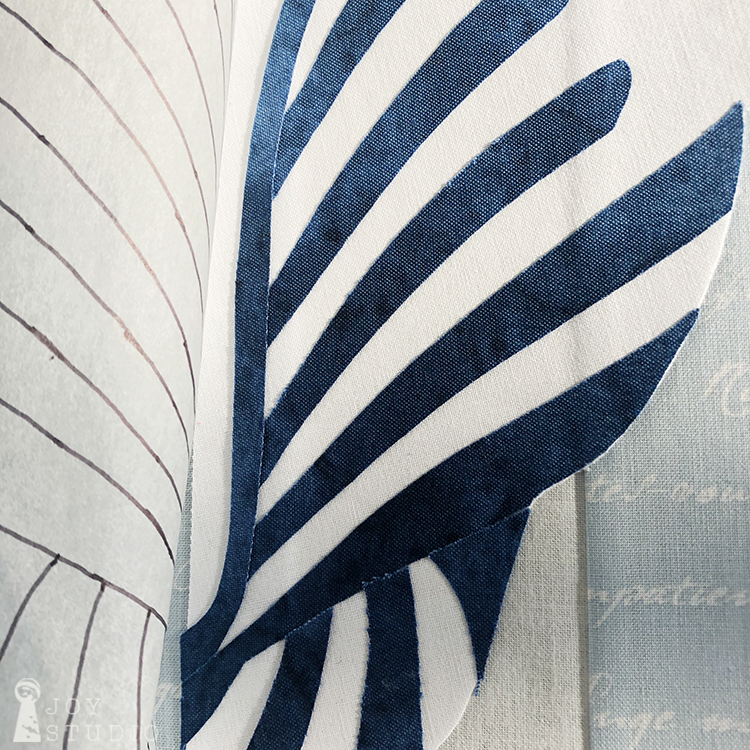

•
Here is how the rest of our row three hats look like before stitching, except for gray. I confess, jumped ahead to sew all like colors to avoid so many thread changes. You can notice that we swapped out black fabric for the pin heads to show up better or you can stitch these if you like.
Also, I cut all the green trim on last hat (below) to include all of the round beading detail. You can eliminate this if you do not wish to do that much extreme cutting and replace with French knots or some other type of decorative stitching or trim.

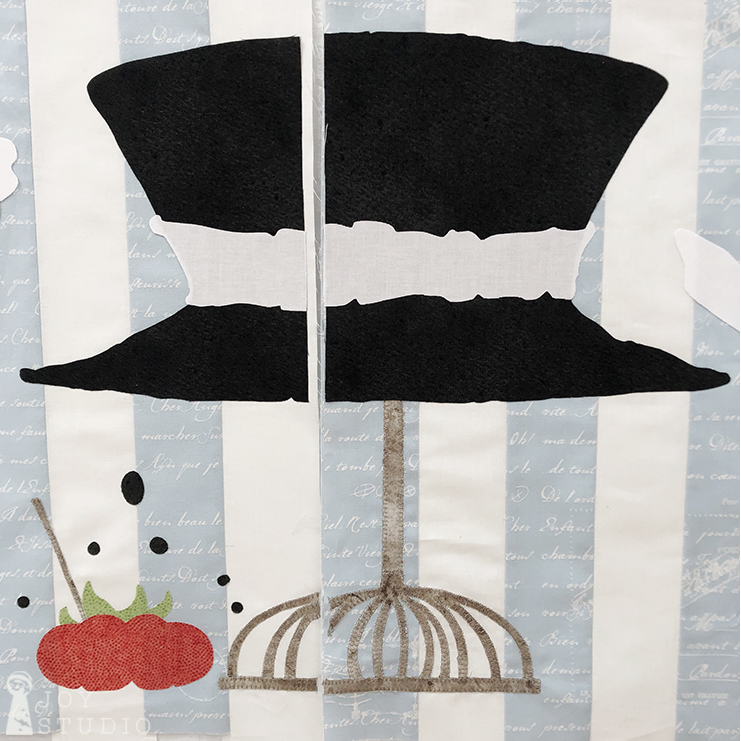

•
Have I mentioned lately that we are using my two new collections, Painters Palette and Couturiere Parisienne for this project? And we are loving the rich colors and painterly textures of these gorgeous fabrics from
Riley Blake Designs.
I hope you have enjoyed seeing our Hat Shop (Atelier de Chapellerie) windows progress and now, we would LOVE to see yours! So, if you would . . .
post a photo of your progress and use #hatshopsewalong on your social media channels
so we can find them,
FOLLOW here, on the blog:
greatjoystudio.com/blog
And/Or
@jweckerfrisch on Instagram or Joy Studio on Facebook
We will be happy to send you these CUTE add on appliqué and bonus hat pattern GIVEAWAY! Vintage spools, buttons and button jar.
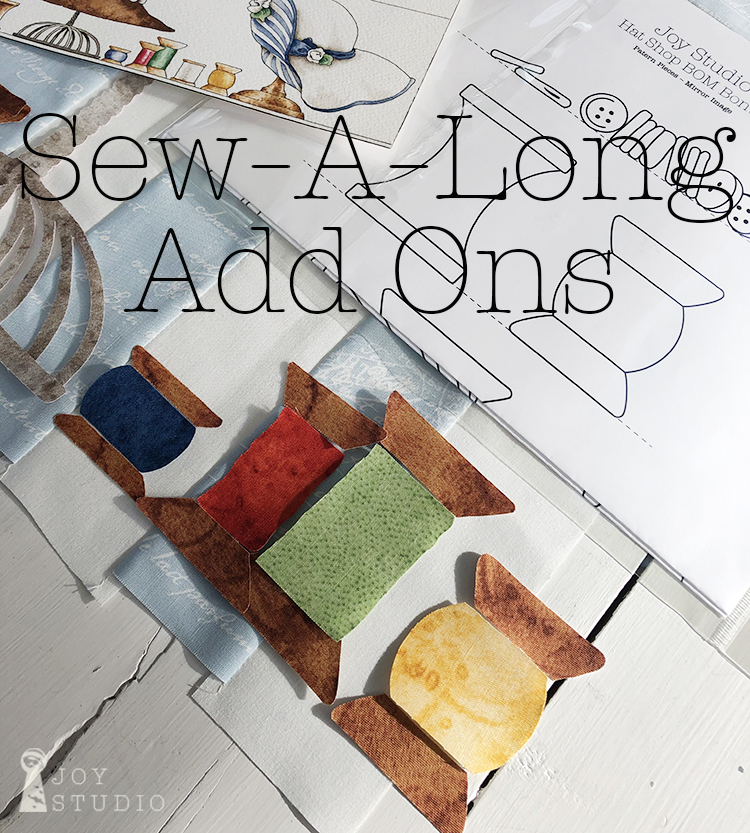

•
Drop me a line if you have any questions or comment here. janet@greatjoystudio.com
Happy hatting this week!
by Great Joy Studio | Jan 29, 2020 | Quilting & Fabric
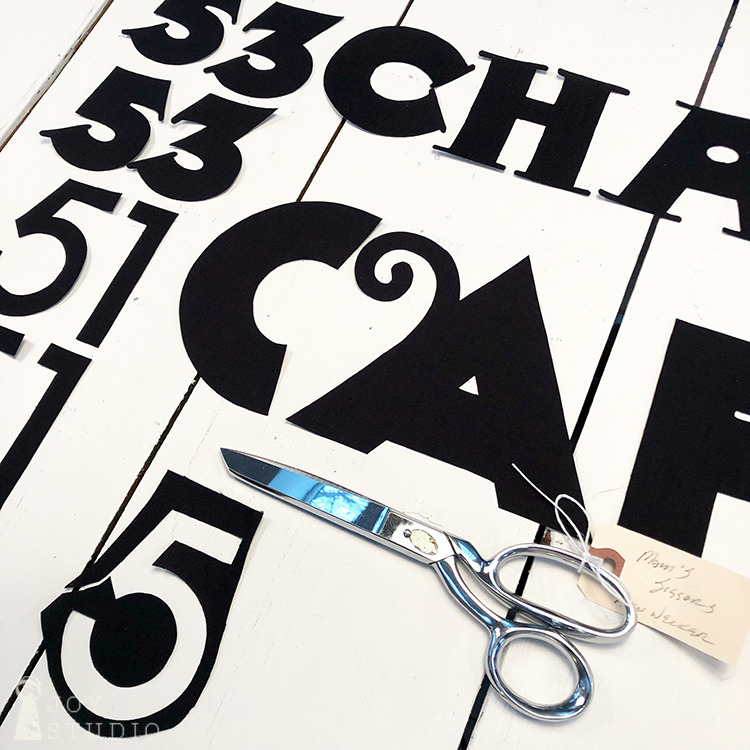
Welcome back to the Hat Shop Sew-A-Long!
Picking up from Week 1.
Tracing your appliqué pieces.
In addition to numbering by block and row we also used different colored Sharpies for each row. This offers another visual reminder to help identify similar pieces quickly. Hopefully this step is behind you however, if you are preparing your appliqué pieces each week, this may be helpful.

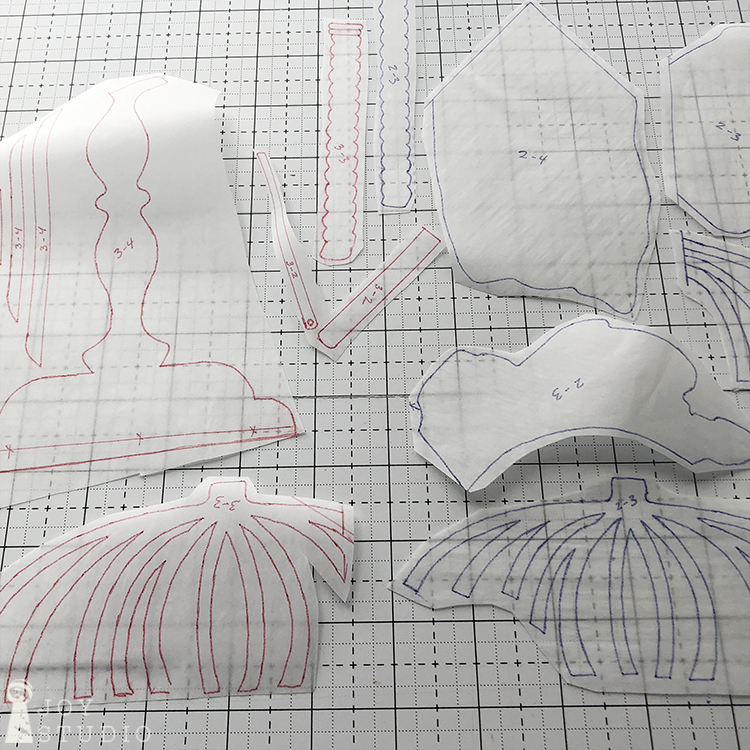
This week, fusing row 1.
Making an appliqué placement door.
This is a practical method that should help with accurate placement of detailed appliqué. Take one sheet of tracing paper, a black Sharpie and your mirror image pattern for each of your four blocks. Rough trace everything in teach block including the solid, block finish size outline. Also indicate the dark and light stripes. There is no need to take a lot of time with this. Since the tracing is mirror image, turn it over revealing the direction of items as they appear on your cover.
Note: Be certain that you are working with the correct blocks (if you chose to do stripes) that match the marked (on your pattern) dark and light stripes.
I chose to begin with block 2 because it had the focal red hat appliqué. Take your second pieced (or solid) block and place the tracing over it. Try to match up as best you can to your striped drawing using the vertical background pieced stripes as your guide. Be mindful of top to bottom placement as well. When you are satisfied, pin tracing paper pattern and fabric block together down one side. My piecing was a little bit off but block seams were fairly consistent at 1/4″. If yours are off also you will need to refer back to the blocks in each previous row as you continue vertically, keeping your stripes lined up.
Then you can either choose to tape your sandwiched piece down on one side or pin onto a pressing mat to eliminate shifting before pressing. My suggestion is to do this on the left side so you can open your pattern door as you would a book. Below are a few photos demonstrating this step. The order you will be fusing is:
white underneath parts of the hat,
gray hat stand base,
vertical post,
horizontal base bottom bar,
red hat
and then the black bow.

•
You can see how easy it is to position, coax and nudge your pieces accurately using this method and a pair of tweezers. Once it is where you like it, press! Hold hot iron on your appliqué as long as the fusible product manufacturer recommends.
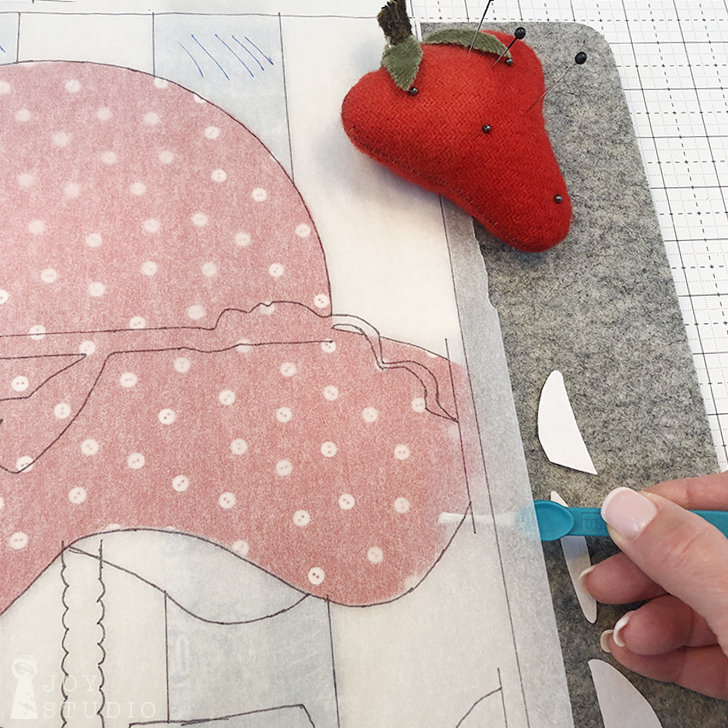
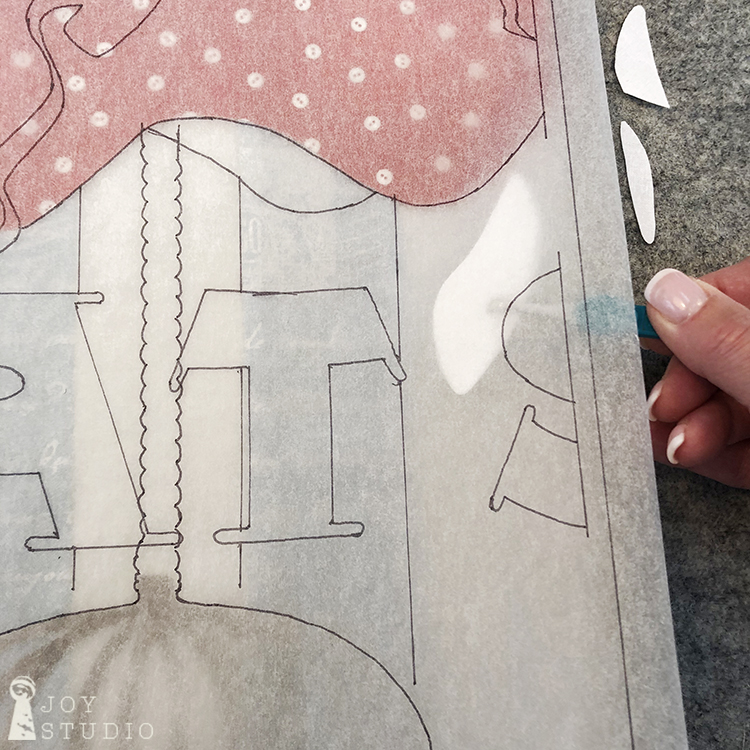
•
I was unable to post our full length version but here is a short video demo that will add a bit more clarity to the above method for placement accuracy. I will also try to post partial footage on our Instagram story today @jweckerfrisch and add to my profile in Highlights to keep this available.
Adding the text.
It is up to each maker to decide when to add the Hat Shop or Chapeaux text. You may choose to fuse your letters by the block and assume they meet/seam together OK or to position after joining all four blocks in the top row. The latter I think is my comfort zone. Remember the window mullions will offer a little forgiveness and cover any parts that do not quite match up.
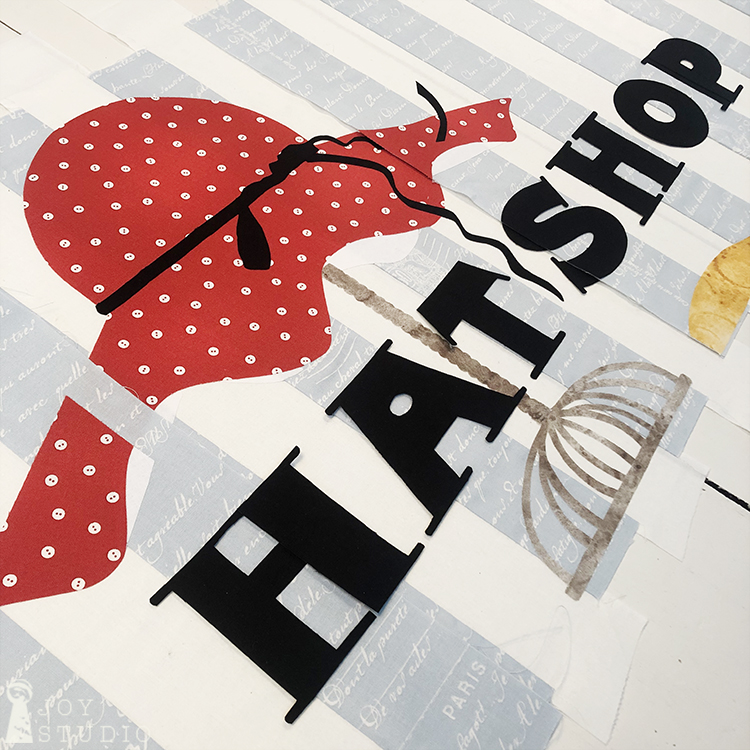
•
Sewing the details!
If you want to add decorative stitching and other trims to enhance each block, you may want to do that now, before piecing all four blocks together for easier turning. It’s always a good idea with fusibles to at least secure your appliqué with some stitching. Blanket stitch has become my preferred. Sewing is the intimidating part for me although I’m getting a lot of practice lately. All of you more experienced sewers could really have some fun with this part of the process! I can’t wait to see what you do.
Watch for the Show Us Your Progress Giveaway on Saturday!!
•
Below is a sample of some fancy stitching that our friends at Aunt Henri used. She will have a video tutorial on this soon.

Have some fun this week hatters!
•
Fabrics we used are,
Painters Palette
and
Couturiere Parisienne
from Riley Blake Designs and AVAILABLE in quilt shops now.
by Great Joy Studio | Jan 22, 2020 | Quilting & Fabric
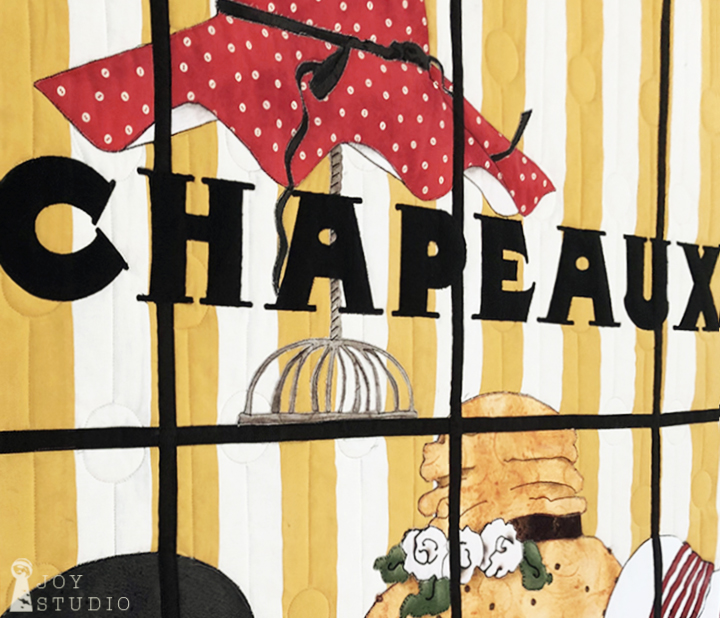
Hat Shop Sew-A-Long begins today!
What better way to start off than with a blog follower’s GIVEAWAY! We have a bonus hat plus some fun sewing related add on-s for this project that were included in the original art but are also cute stand alone-s. Oh, and did I mention, we are including some of my new fabric fat quarters to that!! Chances are if you are participating in this Sew-A-Long, you are already following here, on the Joy (blog) Journal. If not, simply click on the subscribe button above right if you would like to enter for a chance to win the bonus pattern. Follow us on Instagram too for another chance with a comment tagging a friend. @jweckerfrisch You can still enter by subscribing even if you are not participating in the SAL.

•
As you read in the previous announcement post, I am sharing my art that we have translated to appliqué design. Please know that I am not a qualified expert in sewing technique and/or quilt assembly. I wanted to remind everyone of this up front. This is my first time making the project also, together with you. It is the 5th quilt I have pieced! One of them was “doll” size too so, I’m not sure that one even counts. The encouraging news is, that even a beginner like me can make these charming appliqué blocks and have fun.
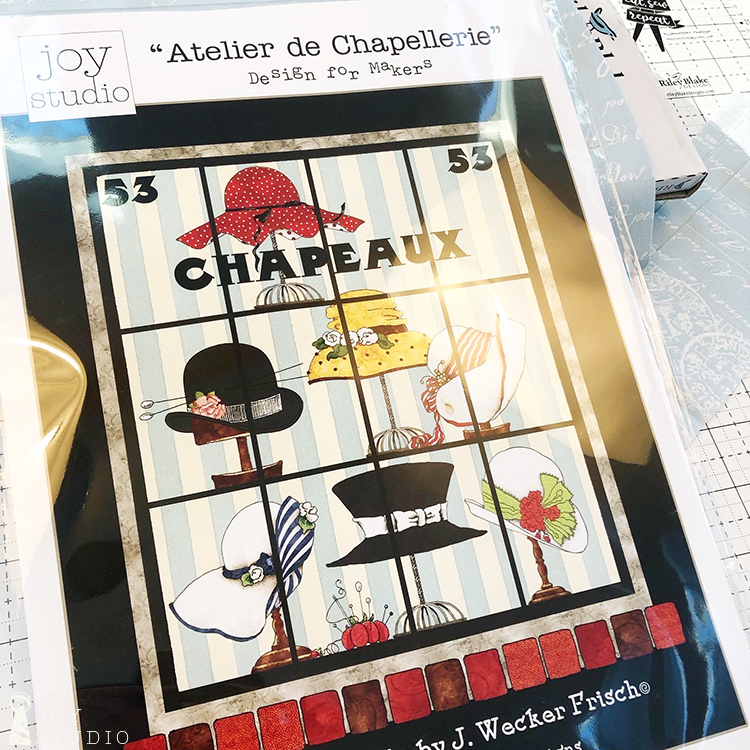
•
Raw edge fused appliqué is the method that works best for my very detailed images and one I am most comfortable executing. Our pattern was designed to work with this technique only, although you can certainly add an allowance to create turned appliqué if you choose. I am still learning so please feel free to comment any tips, questions, or critiques below or email to janet@greatjoystudio.com. I’ll do my best to address them all.
•
OK, let’s get started!
We will be making the 12 blocks that make up the window background in the main body of the quilt this week. First decide if you want a striped or solid background. We chose to make a striped background using Couturiere Parisienne light blue text (#C8850-BLUE) and Confetti Cottons vintage white (#C120), both from our fabric partner, Riley Blake Designs. As indicated on the pattern, you will be cutting equal number of 2.5″ x 18″ (or longer) strips from both, for a 2″ x 17″ finished size, 1/4″ seam allowance. If you choose a directional fabric as we did, you will be cutting your strips parallel to the selvage.


•
Some of the blocks begin with a light strip and others begin with a blue and in several blocks, the stripes overlap! As you can see in the photos below, we flipped the pattern over and taped all four blocks in the top row together, matching the horizontal dashed seam lines, to our window in order to view the pattern lines as they will appear. Then we marked the darker stripes with a highlighter for an easier visual reference. The top row then will be your guide as you work vertically for the next two rows of blocks.

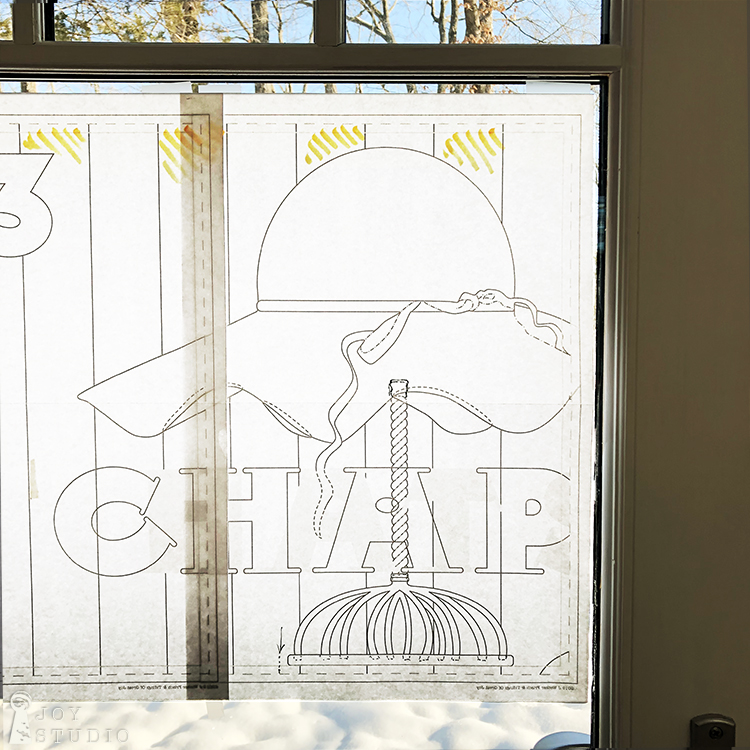
Strip Background Piecing Tip:
I learned the hard way that you will want to stitch each of the strips together from alternate ends of your block. As you can see, I started each strip at the top and my first 3 blocks had a distinct curve to them.
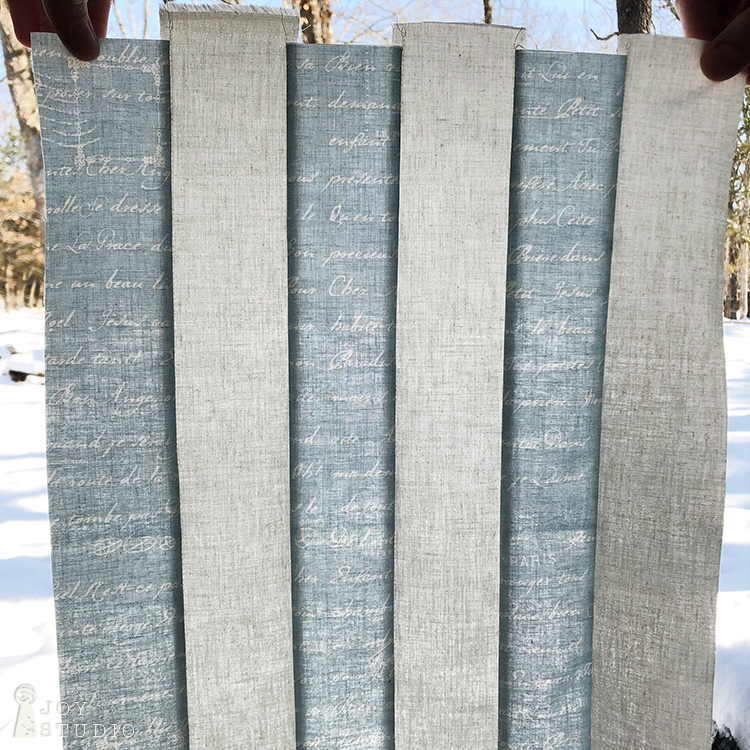
Once you have all of your blocks made, you you are ready to start on you appliqué pieces.
Choosing Fabrics
Pattern correction, not listed is yellow swirl (#C8945-Yellow). You will need a fat eight.
On the back of your pattern in fabric requirements is a list of Riley Black Designs fabrics used for each hat as they appear top to bottom, left to right. You can also reference the picture (worth a thousand words) on the front cover. Our Painter’s Palette Collection from Riley Blake Designs include a wide range of colors, values and artful textures to create from when you want to achieve an interesting watercolor look. I plan to keep plenty on hand to use with former and future projects.
•
Making Your Raw Edge Fusible Apliqué Pieces
Begin by tracing your appliqué pieces onto your choice of fusible web product. We used Pellon 800. The pattern is already in mirror image so trace each appliqué piece from the printed side of your pattern. With so many similar pieces, it is very important to mark each one with a system you will remember. We chose to use the row and block numbers. Once traced, rough cut your fusible pieces.

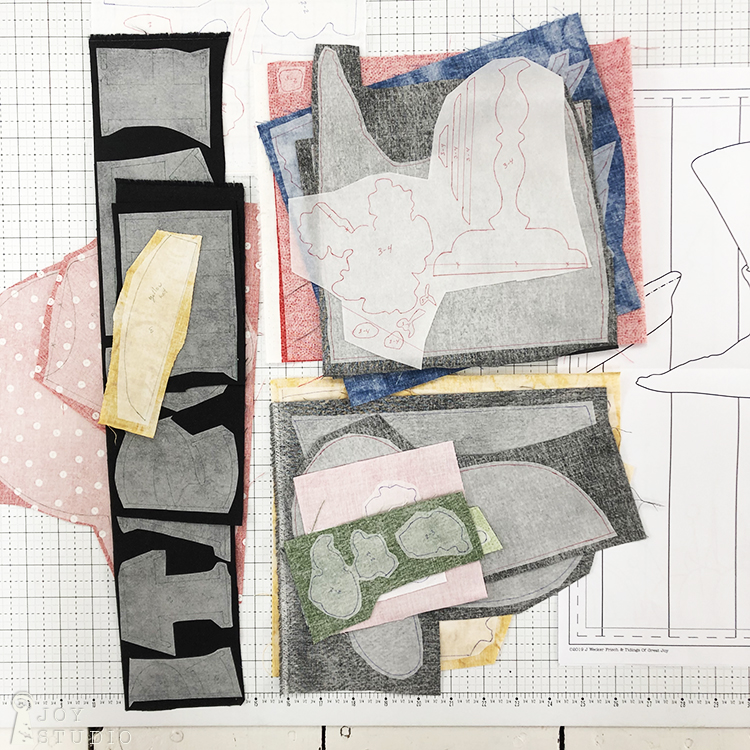
•

•
Organize them on the appropriate block. and you are now ready to fuse!
See you next Wednesday for further fusing instructions.
•





























































